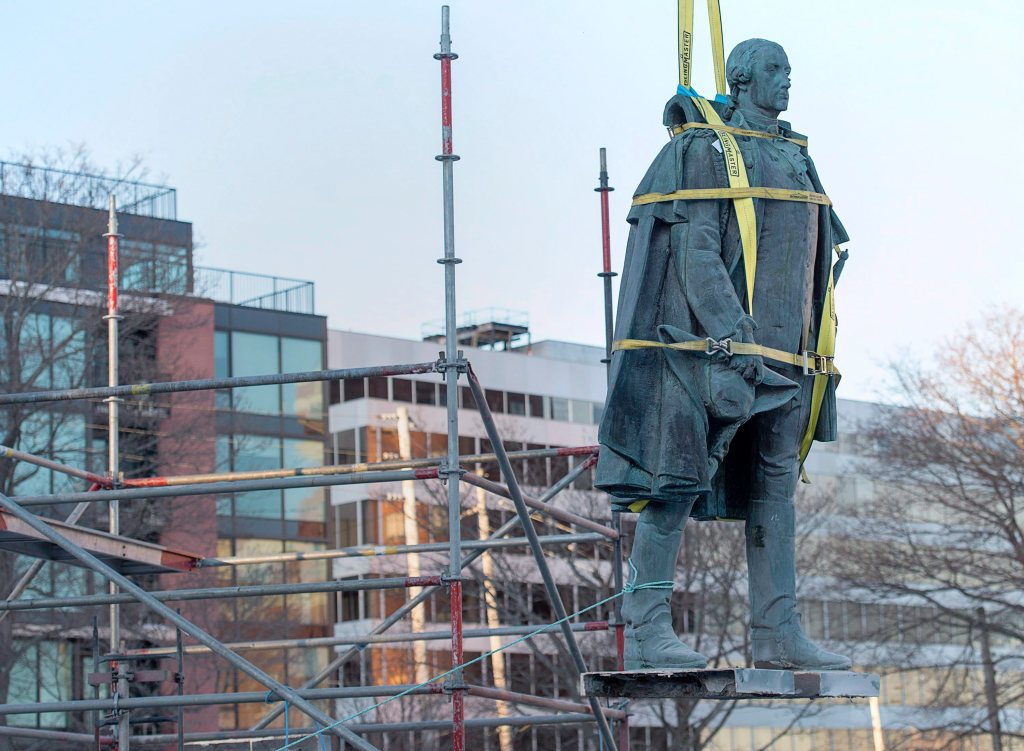Yesterday, Halifax took down its statue of Edward Cornwallis following a last-minute motion by the regional council. After a vote of 12-4, the city immediately removed the statue of its founder and placed it in storage.
Cornwallis was a British army officer who established the settlement of Halifax in 1749. This was the first part of an effort to secure English military influence in Nova Scotia. The Acadian colony had been ceded by the French following the Treaty of Utrecht in 1713, but its predominantly Catholic, French and Mi’kmaq population meant it remained effectively outside British control. Establishing a large English settlement and military garrison was meant to bring things in order with the Crown’s designs for North America.
Videos by VICE
The Mi’kmaq, meanwhile, viewed the unilateral founding of Halifax as a violation of an earlier peace treaty they and the Maliseet had signed with the British in 1725. Cornwallis’ arrival and sudden spate of fort-building triggered more than ten years of guerilla warfare between the Mi’kmaq and their Acadian allies against the English settlers. As part of the war effort, Cornwallis issued a bounty on Mi’kmaq scalps, promising 10 guineas apiece. The English won the war in 1755, signed peace and friendship treaties with the Mi’kmaq in 1761, and deported more than 11,000 Acadians.
Cornwallis left Nova Scotia in 1752. His statue was erected in Cornwallis Square in 1931 as part of a tourism scheme by the Canadian National Railway.
Cornwallis’ statue has been a local controversy since at least the 1980s. It came to national prominence over the last few years as both Canada and the United States have grappled with how to commemorate their problematic pasts. Most Canadians from outside Nova Scotia are probably most familiar with the statue thanks to a Mi’kmaq mourning ceremony hosted at the site on July 1, 2017. A vigil for missing and murdered Indigenous women was interrupted by five members of the Canadian Forces who were also self-identified “Proud Boys,” a fraternal order of racist ska enthusiasts dedicated to preserving the sanctity of Western Civilization by refusing to crank their hogs. Regrettably, the soldier’s restless vigilance over their own seminal fluid did not avert this week’s council vote.
As in most things, the statue debate in this country played out like a G-rated overdub of the same process in America. There, statues praising the heroes of Confederate slave power had to be dismantled in the dead of night while neo-Nazis marched by torchlight in the streets. Things have been somewhat tamer here. For the most part, civic commemorations of Canada’s imperial heroes have instead been flashpoints for dialogue about reconciliation between settlers and Indigenous peoples. In the wake of Canada 150, a number of schools and federal buildings have had their names changed in the interest of finding a public image that doesn’t immediately evoke the triumph of British Canada’s warm and fuzzy brand of colonialism. (Langevin Block, we hardly knew ye.)
Everytime this issue comes up, regardless of the place or imperial relic in question, there is an immediate objection among many pundits that to tamper with statues or building names or whatever is emphatically Bad. It’s Political Correctness run amok, an infantile outburst over the fact that people from History weren’t as fully woke as a BA in Tumblr demands. The path we travel down is dangerous; something valuable will be lost. Present and future generations will lose one more link in the fragile chain of civic memory that binds us together as a community of citizens. It is better to leave up these historical markers, with all their problematic warts and all, so that this kind of critical conversation never dies, and so that we can appreciate influential people like Edward Cornwallis in their full historical context.
Well and good! We should love nothing more than to see a surfeit of richly contextualized and engaging public history. Halifax regional councillor Lisa Blackburn phrased it as well as anyone when she said that “statues are not how we record history. Statues are how we glorify history.” You will get a much better return on investment with a series of informational placards than a heroic sculpture of an English imperialist keeping his lonely watch over a multicultural metropolis. The statue is an obvious obstacle to reconciliation—even the half-assed sort of symbolic ‘reconciliation’ that this country’s settler governments have so far mustered up. Removing Cornwallis is less an effort to efface history than to make sure that the public spaces of Halifax reflect the history of the Halifax public, and not just the Old Stock imperialists.
Besides: there are lots of things you can do with the statue that will still allow Cornwallis his afterlife of teaching people about Canadian history. It can go to the Canadian War Museum as part of a collection on the Anglo-Indian colonial wars. Better yet, ship him to the Canadian Museum of History. They can put him in the First People’s Hall next to a copy of the Indian Act or that drawing of the last Beothuk. The US turned the hotel where Martin Luther King Jr. was assassinated into their Civil Rights Museum; the possibilities for old Cornwallis are endless.
The statue coming down is long overdue. This country’s historical consciousness of itself—such as it is—will be in no way diminished because Edward Cornwallis no longer stands on a pedestal in the square bearing his name. Anyone genuinely worried about his legacy in the city he founded can take comfort in the fact that Halifax still stands, two and a half centuries later, and was able to peacefully hold a referendum on a hotly contested piece of its own political history.
I dunno man. That sounds like a much more rewarding legacy than some obnoxious statue.
More
From VICE
-

NASA/YouTube -

Unitree G1 (Credit: Unitree) -

Anadolu/Contributor/Getty Images -

Picture by Stéphane Mouchmouche / Hans Lucas / AFP via Getty Images
